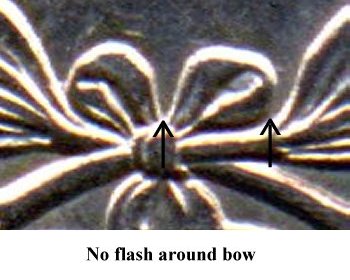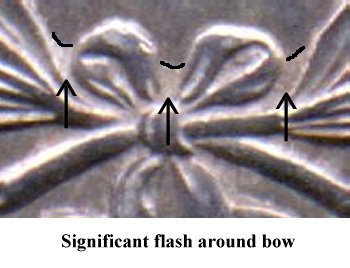

|
|
|
Die Flash around Bow Loops
Studying the die states around the bow knot and adjacent lower left and right wreath areas can enhance attributions of Open Bud reverse dies. This region of the die presents varying degrees of remaining metal or "flash" surrounding the bow knot loops similar to that found in extruded plastics component of scale model kits. Many pieces in these kits require the manual trimming of residual plastics to properly define the part required for the scale model under construction. This "flash" concept can be applied to the region surrounding the bow knot loops and its adjacent lower wreath region. The height of the flash and its shape at the point of intersection with the bow know loops and surrounding wreath can produce a unique diagnostic for a reverse die. In numerous cases, the bow flash will also contain die lines that can enhanced the identification of reverse dies.


In the first scan of a reverse die from 1845, the region between the two bow loops is free of flash and presents a distinct separation of the bow loops. The region between the right bow loop and its adjacent right leaf is also free of flash. In the second scan, another 1845 reverse die shows filled regions around the bow knot loops. Between the two bow loops, the flash appears as an upward facing arc. This upward facing arc is typical and its height, in relations to the bow ribbon height, will vary across reverse dies.
The flash around bow knot loops can be a supporting diagnostic point for New Orleans mintmarked reverse dies. For Philadelphia reverse dies, the presence and shape of the flash can be used as a primary diagnostic when no die cracks or die lines are present. Bow flash will be recorded as necessary and supported by scans when its presence is a key diagnostic.